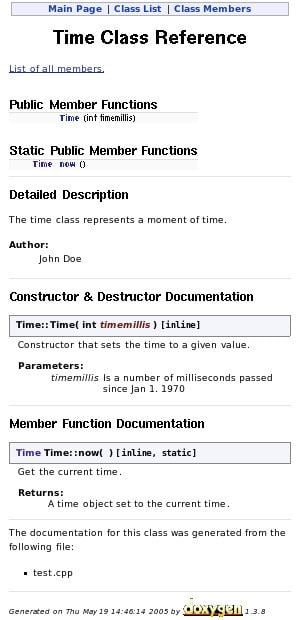Developer(s) Dimitri van Heesch Operating system | Written in C++ | |
 | ||
Initial release 26 October 1997; 19 years ago (1997-10-26) Stable release 1.8.13 / 29 December 2016; 2 months ago (2016-12-29) Repository github.com/doxygen/doxygen | ||
Doxygen (/ˈdɒksidʒən/ DOK-see-jən) is a documentation generator, a tool for writing software reference documentation. The documentation is written within code, and is thus relatively easy to keep up to date. Doxygen can cross reference documentation and code, so that the reader of a document can easily refer to the actual code.
Contents
Doxygen is free software, released under the terms of the GNU General Public License version 2 (GPLv2).
Design
Like Javadoc, Doxygen extracts documentation from source file comments. In addition to the Javadoc syntax, Doxygen supports the documentation tags used in the Qt toolkit and can generate output in HyperText Markup Language (HTML) as well as in Microsoft Compiled HTML Help (CHM), Rich Text Format (RTF), Portable Document Format (PDF), LaTeX, PostScript or man pages.
Uses
Programming languages supported by Doxygen include C, C++, C♯, D, Fortran, IDL, Java, Objective-C, Perl, PHP, Python, Tcl and VHDL. Other languages can be supported with additional code.
Doxygen runs on most Unix-like systems, macOS, and Windows.
The first version of Doxygen borrowed code from an early version of DOC++, developed by Roland Wunderling and Malte Zöckler at Zuse Institute Berlin. Later, the Doxygen code was rewritten by Dimitri van Heesch.
Example code
The generic syntax of documentation comments is to start a comment with an extra asterisk after the leading comment delimiter '/*':
Many programmers like to mark the start of each line with space-asterisk-space, as follows, but that is not necessary.
Many programmers avoid using C-style comments and instead use C++ style single line comments. Doxygen accepts comments with additional slash as Doxygen comments.
The following illustrates how a C++ source file can be documented.
An alternative approach for documenting parameters is shown below. It will produce the same documentation.
Richer markup is also possible. For instance, add equations using LaTeX commands:
